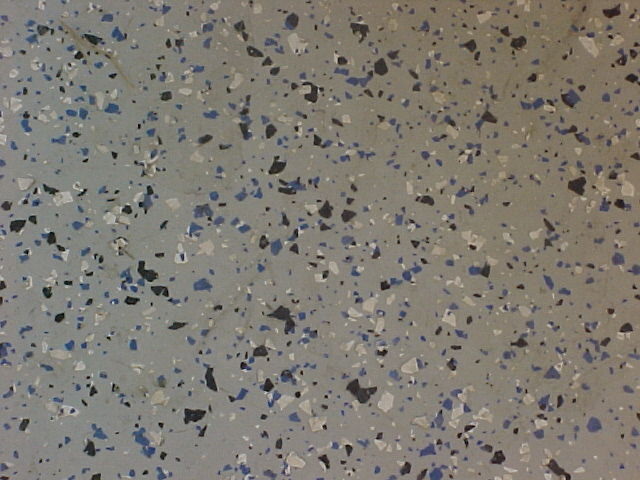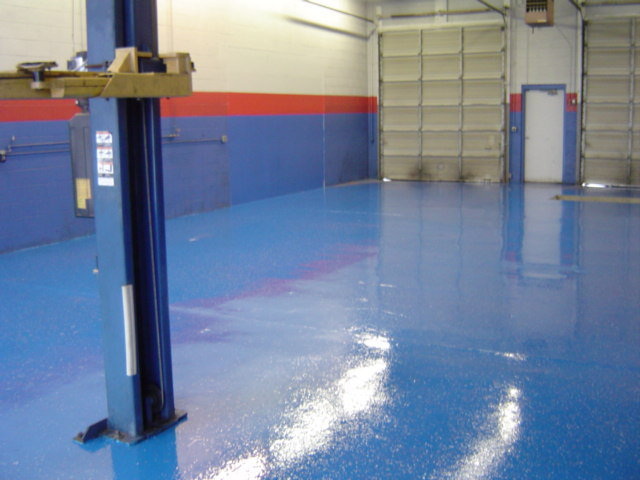Epoxy and Urethane Floor Installation
When considering a floor coating, epoxy flooring is the most popular seamless flooring system in both the commercial and industrial markets. An epoxy coating consist of a polymer and co-polymer (or a resin and hardener) that when properly mixed together, permanently crosslink and change from a liquid to a solid, very similar to a hard piece of plastic. Since it is applied as a fluid liquid and then hardens, it is seamless and is often referred to as "Seamless flooring", an ideal floor for laboratories, clean rooms, rest rooms and kitchens, as there are no places for dirt, germs and bacteria to hide. Epoxy offers several advantages as a floor coating, the most important being epoxy's natural adhesive properties that allow it to form a tenacious bond to properly prepared concrete. Even customers considering a urethane or other coating as their final wear surface may select epoxy as the primer due to its great adhesive properties.
Epoxy coatings come in a number of colors and different textures like high gloss, orange peel or flat finish. Epoxy coatings can be water based, solvent borne or 100% solid allowing epoxy floors to be installed with little or no VOC's (volatile organic content) for installations in facilities where people, product and food stuffs are present without fear of odor contamination or disruption to production in nearby areas.
Epoxy coatings are sometimes loaded with fillers such as sand, colored quartz, paint chips, glitter and other innovative ideas to produce decorative effects or to simply beef up the coating thickness. Certain epoxy coatings are engineered to harden at substantial thicknesses making them excellent for repairing damaged floors.
If epoxies have a disadvantage, it is that they become extremely hard and continue to harden over the life of the coating. While hardness may seem like a desirable characteristic, epoxy coatings are very easy to scratch and chip. Just regular foot traffic on an epoxy floor produces millions of micro abrasions dulling and clouding the finish causing the floor to look prematurely old and worn. For that reason, most customers and architects choose to topcoat epoxy with a more abrasion resistant material such as urethane to maximize the image and life of the floor.
Although epoxy is the most popular seamless floors we install, beware of a "one size fits all" flooring material. Hoboken Floor Refinishing works closely with our clients to select a flooring system to meet their individual needs based on their specific environment.
Epoxy coatings are sometimes loaded with fillers such as sand, colored quartz, paint chips, glitter and other innovative ideas to produce decorative effects or to simply beef up the coating thickness. Certain epoxy coatings are engineered to harden at substantial thicknesses making them excellent for repairing damaged floors.
If epoxies have a disadvantage, it is that they become extremely hard and continue to harden over the life of the coating. While hardness may seem like a desirable characteristic, epoxy coatings are very easy to scratch and chip. Just regular foot traffic on an epoxy floor produces millions of micro abrasions dulling and clouding the finish causing the floor to look prematurely old and worn. For that reason, most customers and architects choose to topcoat epoxy with a more abrasion resistant material such as urethane to maximize the image and life of the floor.
Although epoxy is the most popular seamless floors we install, beware of a "one size fits all" flooring material. Hoboken Floor Refinishing works closely with our clients to select a flooring system to meet their individual needs based on their specific environment.
Contact Hoboken Floor Refinishing for all of your epoxy flooring needs!




